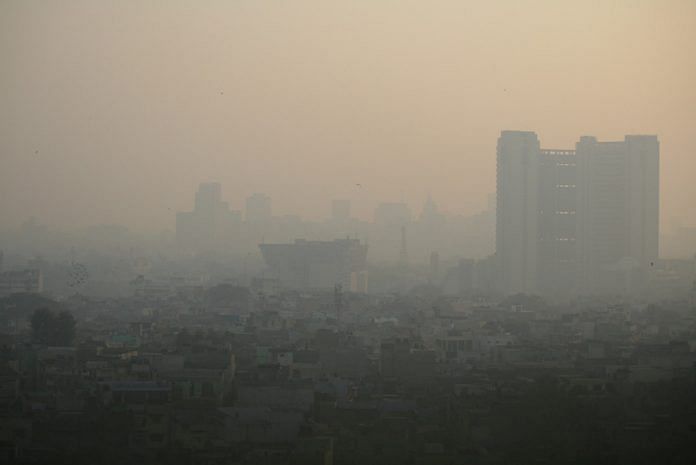On 9 October, the Supreme Court had banned the sale of all firecrackers in Delhi NCR till 31 October. Read our previous TalkPoint — if public health justified SC stalling the sale of fireworks for Diwali. Many hailed the SC’s move, since the air quality in the National Capital Region had crossed hazardous levels after Diwali last year.
Question: Has the air quality changed post-Diwali after the implementation of the cracker sale ban in Delhi NCR?
Cracker sale ban had little impact on Delhi’s air pollution, but doesn’t mean it was not needed
 Amit Bhatt
Amit Bhatt
Director of environmental group WRI India
As I write this piece on Friday morning, a day after Diwali, the US Embassy’s air quality monitoring station in Chankyapuri shows a reading of 999.
This is the maximum level that the sensors can read, meaning the actual air quality might be even worse. So, did the Supreme Court’s ban on selling firecrackers help improve air pollution at all?
A quick look at Delhi’s air quality reveals that air pollution is a continuous problem. As per the Air Quality Index (AQI), Delhi did not have a single day of good AQI for two years till June 2017. The monsoon and favourable climatic conditions did improve the air quality for next two months, after which the AQI was back in the red zone again.
As per UE information, motor vehicle exhaust is the largest contributor to air pollution and is responsible for 30% of PM2.5 (particulate matter with a diameter of less than 2.5 microns) concentration in greater Delhi, followed by biomass fuel and industries that comprise 20%. Dust, diesel gensets, and open waste burning come in third.
Therefore, it will be immature to expect that the ban on firecracker sales alone will solve Delhi’s air pollution problem, as that needs tangible action throughout the year.
Air pollution due to firecrackers is an episodic event that probably impacts the air quality for four to five days. However, it is important that these days are managed well. The ban is a welcome step.
Solving Delhi’s air pollution problem needs continuous action with strict monitoring and control. Otherwise, we may be discussing the same issue during Diwali next year as just another token measure for a monstrous problem.
We have definitely seen lower levels of air pollution this year as compared to the last few years
 Barun Aggarwal
Barun Aggarwal
Co-founder, Care for Air, & CEO, BreatheEasy Consultants Pvt Ltd
The firecracker sale ban by the Supreme Court has been a welcome move for many.
At Paharpur Business Centre and BreatheEasy, we have been tracking Delhi’s air quality for the last 25 years on a daily basis.
The PM2.5 levels have breached the safe levels prescribed by the Central Pollution Control Board (60 micrograms per cubic metre) every single day between Diwali and Holi (through all the winter months) every year, with an extremely high episodic exposure on Diwali night and a few days after.
This year, there have been many environmental groups that have worked very hard to try and reduce the sale/use of fireworks during Diwali. Care For Air and #MyRightToBreathe have dedicated themselves to reducing air pollution, and taking on the various issues that lead to air pollution, with burning firecrackers being just one of them.
This year, the PM2.5 levels at 1:30am on Diwali night in central Delhi were recorded at 505µg/m3. By 7:30am, the numbers went up to 1,050 µg/m3. This was because of dispersion of the pollutants across the city. However, last year, the readings of PM2.5 in the same spot with the same equipment were 2,400 µg/m3, while four years ago, we had a reading of 3,200 µg/m3.
Hence, we have definitely seen lower levels of air pollution this year as compared to the previous few years. Meteorological conditions have been favourable, and helped with reducing air pollution this year as compared to previous years.
The ban was too little, too late
 Sherebanu Frosh
Sherebanu FroshThe 2017 SC ban on the sale of firecrackers ended up being ineffective, with post-Diwali pollution numbers reaching crisis levels. The ban was too little, too late. The vendors cried victim, those that would burst crackers sobbed hypocrisy, and our health meanwhile, literally, choked. A public health disaster, yet again.
Clearly enforcing a ban against the sale (not the use) of a single cause of pollution, and introducing the ban late in the game, was not enough. Firecrackers have to be decoupled from the traditions of the festive season.
Government institutions, industry associations, and designers can create dazzling installations, public events and shows to feed our preference for brightness, light, and colour this season without resorting to smoke. For the cracker sale ban to be effective, make it pan-India and year-round.
But more than that, the ban should not be on a cause, it should be on an outcome. The ban should be on dirty air. All illegal burning of crop and domestic waste must be stopped. If the police cannot do so, bring in the army. Nothing is more important for our national well-being.
In cities, construction and road dust that sits (illegally) in great piles has to be removed or covered. All of us can make a quick call to civic authorities on this subject. Excessive consumption of electricity, diesel, and petrol by any individual should be taxed out of existence. None of these measures comes at a small cost, but a nation of stunted children with blackened, shrunk lungs and shortened lifespans is not a price we are willing to pay either.
Pollution levels worsened on Diwali night due to calm wind and higher moisture in the air — as predicted
 Anumita Roychowdhury
Anumita Roychowdhury
Executive Director (Research and Advocacy), Centre for Science and Environment
Delhi and NCR towns have experienced the season’s first pollution emergency during Diwali this year. But this could have been worse without the ban on the sale of firecrackers.
Analysis of air quality data from 13 air quality monitoring stations of the Central Pollution Control Board, the Delhi Pollution Control Committee and the Indian Meteorological Department shows rapid pollution build up during Diwali night.
Pollution levels worsened due to calm wind and higher moisture in the air – as was predicted. The key NCR towns of Gurugram and Ghaziabad as well as Delhi are equally affected, but Delhi shows comparatively higher level. It has not been possible to make direct comparison with the smog level of Diwali 2016, as comparative data for all stations is not available. However, levels at individual stations at Mandir Marg, R.K. Puram, and Punjabi Bagh show comparatively lower levels this year.
It is clear that the combination of firecrackers and adverse weather conditions have pushed Diwali pollution to the emergency category. This demands longer-term and systemic action, rather than a one-off ban. The Supreme Court has already directed a phase-down strategy with the help of regulation of chemicals, standards, reduced quantum of crackers, controlled bursting of crackers through community events, local controls among others. This must be implemented without delay for a longer-term solution to the problem.
Delhi and NCR cannot remain only on emergency mode to address this public health crisis. This demands longer-term strategy to control pollution from continuous pollution sources including vehicles and industry, as well as episodic pollution from firecrackers and farm fires, for sustained and longer-term gains.
Compiled by Divya Narayanan and Talha Ashraf



